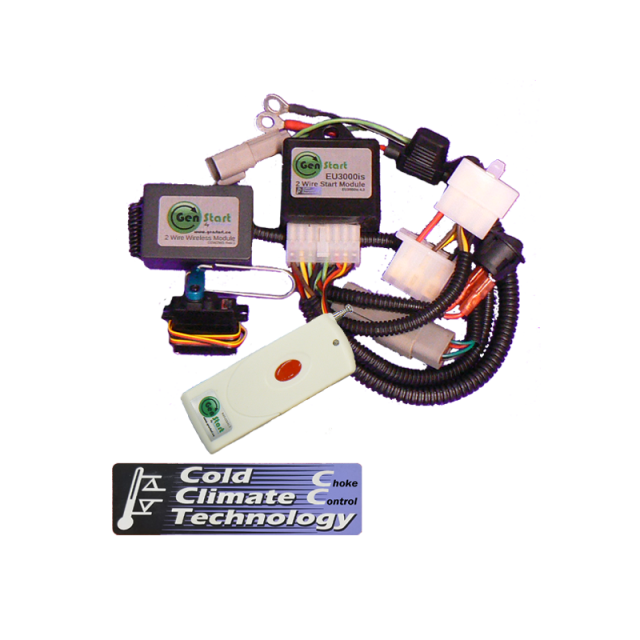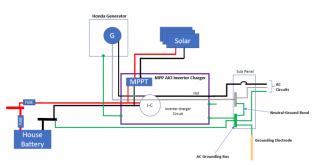Thanks for your responses.
Filterguy - Sorry I should have mentioned, the generator is a Honda EU3000IS. From what I've read, it has a 'Floating Neutral'. The ground and neutral are not bonded together. I'm guessing that means that Possibility #2 you mentioned would be more likely to occur? I do have to admit though, you did find another flaw in my design. I was scratching my head when you mentioned my heater was 1000w. I was under the impression I was buying a 24w heater. I didn't realize the thermostat was such a big draw until seeing your post. So I'll be returning that, and was going to try and test one of these in its place
https://www.amazon.ca/gp/product/B074HVYDV1/ref=ppx_yo_dt_b_asin_title_o02_s00?ie=UTF8&psc=1
The heat pad is to maintain temp above 0 degrees C in the winter for my all-in-on MMP Solar unit in an outdoor enclosure, not my batteries. My batteries are Kilovault CHLX series, so they have their own built in heater and BMS.
Arbee - You are right to wonder why I'd go to the effort if other steps in the process were manual. But this is just one piece of the puzzle I was hoping to sort. The next step would be the auto start generator. I haven't gone deep into it yet, but I have found this
- Start and Stop your EU3000is with any switch, 2-Wire AutoStart control or automatically from your off-grid inverter. - Start and Stop your EU3000is with our Wireless Transmitter from up to 1000 meters away! - NEW Cold Climate Technology Choke Control for dependable starting at any...

genstart.ca
and it appears that it will do the job at first glance. But I would also be very grateful for your offered free advice if you have already been down that path and can ease my frustrations before they occur

I also appreciate your suggested transfer switches, but don't they seem a bit overkill? Again, this transfer switch is ONLY to manage the power source for the heat pad, as it needs power before the inverter turns on. The invert has it's own transfer built in to manage the transfer of power from my generator to main breaker panel.
bwf: it sounds like ideally you'd love the whole thing to be automated but might be willing to tackle each step manual at first and then introduce automation for these steps with time, especially in mind of your budget.
Maybe that's wrong: and right or wrong it's fine.
Q1) What is the condition for which to get this whole thing going (i.e. the generator started)? Is it the two fold condition of a certain amount of lumens (i.e. the sun has come up) and the presence of temperatures below freezing?
Q2) Is the heating requirement there to keep the MPP Solar 2424 at above freezing temperatures before energizing it? Is the factor that indicates it okay to energize the MPP Solar 2424 the presence of ambient 1 degree C temperature or higher?
Q3) When it's indicated to energize the MPP Solar 2424, is its sole source of power your battery bank or are other things energizing the MPP Solar 2424, and if so what (e.g. the generator)? When you wrote: "Then I will turn the unit on (the MPP Solar 2424??) which will then supply the power from my battery bank." did you mean to say that the unit will be
supplied power
from your battery bank?
I'm not trying to play word games...I just want to understand so I can help you.

Q4) Is the presence of current on the line from the MPP Solar 2424, which is designated to power the heating blanket the condition by which not only power for the heating blanket is switched from the Generator to the MPP Solar 2424, but is this the same condition that turns off the generator (buzz speak: grounds the magneto)?
Q5) If temperature remains above freezing you need not involve the generator or heating blanket, correct? In fact you need to have the MPP Solar 2424 energize the heating blanket, correct?
Q6) What happens if, while the MPP Solar 2424 is operating, the temperature dips below freezing. Do you want to close the circuit from the MPP Solar 2424 to the heating blanket? If so at what temperature do you want this to happen (e.g. 5 degrees C)?
Q7) What happens once the heating blanket brings things above freezing? Is there a temperature where you want the heating blanket to cut out?
Q8) What turns off the MPP Solar 2424, the lack of sunlight?...the lack of above freezing temperatures if the heating blanket doesn't work? Both, neither, something else?
Q9) What fuel do you plan on running the generator with?.. Gasoline? Do you have access to propane or piped in natural gas?
Q10) Is this the sole purpose for the generator?
There are cheaper automatic transfer mechanism to come by. The won't though be up to the US home standard of UL 1008 for automatic transfer switches. I don't know the Canadian equivalent much as I strongly suspect one that's comparable exists.
The link to your autostart device is not only an expensive unit, but just a manually starting device from a distal location. If you run gasoline you still may need to physically visit the generator to fuel up...not to mention manually engage other parts of this process.
A GSCM or GSCM mini from Atkinson Electronics can start or stop your generator based on shorting its pins 5 and 6, or stopping the generator by unshorting these points on the device. Sensors that measure things like temperature, lumens, time of day, or voltage etc. could be attached as indicated. One customer of US Carburetion, who sells gasoline to propane/gasoline/natural gas conversion kits for generators, fired up their generator from a large propane tank in the field, based upon the level of water in an animal drinking trough, energizing the pump to supply more water. In that case it was cheaper than having the utility draw another power line from a pole. My point is pretty much anything that's measurable can serve as the reason to turn on or off a generator with battery crank. Some customers have their systems set up to crank the generator simply if its cranking battery runs low, so as to power up it's own battery.
~~~~~~~~~~~
If I'm correct, this setup is all about insuring that the MPP Solar 2424 is not energized below freezing, correct? If so, is a larger battery bank to solely energize the heater, and possible more solar panels not feasible as a solution, bypassing the MPP Solar 2424 until above freezing temperatures have been reached?






